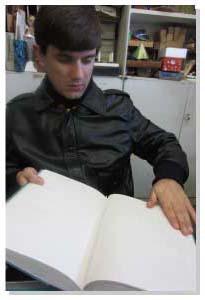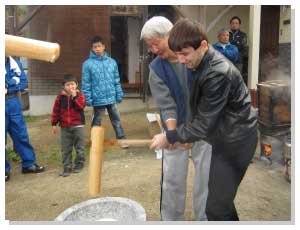- HOME
- Alumni News
- Siyovush Ilyasov (13th trainee)
- Siyovush's Final Report
Siyovush's Final Report
REPORT OF TEN-MONTH TRAINING IN JAPAN
The Duskin leadership training in Japan was my first study abroad which gave me new experiences, knowledge and skills. Since I attended this training, I have been able to have better thoughts than before and it has also made me believe more in myself. During these ten months, I was with other trainees from different Asia-Pacific countries who had different disabilities, and also with Japanese people. I have become acquainted with Japanese lifestyle, have got to know more about their lives, customs and traditions, jobs and so on. Now I am going to write about this ten-month experience.
It was very exciting to set foot in Japan at the end of August 2011. I was the last trainee who landed at the Kansai Airport and I met the JSRPD staff and the other trainees. After the opening ceremony in the Duskin office in Osaka, we left for Tokyo and began our Japanese language study at the Toyama Sunrise.
The Japanese class started on September 5, and went on for three months. There were eight teachers who taught us by using different methods which were easy and clear to understand. All the teachers were experienced in teaching and the whole time they tried to make the lessons interesting and funny. Our classes were full of fun and laughter, and we played different games which made the classes thoroughly enjoyable. That was why all of us became able to speak Japanese in such a short time.
In the morning we had group lessons, mostly carried out only in Japanese. In the afternoon the trainee from Vietnam and I studied Japanese Braille. In Tajikistan I had tried learning Japanese Braille alphabets but could not really understood them. It seemed much more difficult than Tajik, Russian or English Braille. However in Japan, when the teachers taught us the rules of Japanese Braille, it became easier to memorize it and in a very short time I was able to write and read Japanese Braille.
After we passed the Japanese Language Proficiency Test, we had two weeks of lecture series on disability movements in Japan. During this time, we also visited some centers such as: the National Rehabilitation Center and also the Human Care Association for peer counseling, where people with disabilities had different activities and studies.
I obtained ample amounts of information about education for the visually impaired during the five months of individual training. As my ambition is to become a teacher, the first and the last trainings which I attended were at blind schools in Hiratsuka and Tsukuba. Compared to the blind-school in Tajikistan where I studied, the Japanese blind schools were much better equipped. The fact is that there are enough teaching materials, Braille text-books and plastic models at Japanese blind schools. All needed materials are available for every subject so students can learn well. One of the simple examples is that in Tajik blind schools there are not enough Braille papers, textbooks or plastic models. I am going to be a teacher and try my best to acquire needed materials for the visually impaired in Tajikistan.

“DAISY: THE BEST WAY TO READ, THE BEST WAY TO PUBLISH”
When I entered the ATDO (Assistive Technology Development Organization), I saw this slogan and learned about DAISY for about a month. I had heard of DAISY, but did not know what the system was like. After learning this new system I found this format much easier to understand than other formats, as they are highly accessible for visually impaired people to read books or get information.
DAISY training was exactly what I needed, because in Tajikistan there are no DAISY books. It is my responsibility to share with other friends when I go back and publish this new system in Tajikistan, so that textbooks would be available for blind university students, and also novels and classic masterpieces will be accessible.
Nowadays in many countries leaders are planning for inclusive education for people with disabilities. In developed countries, their respective ministries of education have already legally signed for inclusive study, and many children with disabilities are now studying in public schools with non-disabled students. In 2010, our president has also signed for inclusive education for people with disabilities in Tajikistan. But, due to its circumstances, the Tajik society is not yet ready to fulfill the task. Unlike in other countries, there is no information support center in Tajikistan, and we do not have enough facilities, Braille books, or materials for the visually impaired. At the Nippon Lighthouse in Osaka which I visited for three weeks, I gained a better understanding of how to realize inclusive education for visually impaired students. What I learned include producing of Braille books and materials, editing books in DAISY, face to face reading, Braille library, cooperation with schools where visually impaired students can study, making rehabilitation courses for the daily living, computer skills and sports – and these are all important elements for inclusive education. One of the things I found most surprising at the Nippon Lighthouse was its volunteer activities. There are approximately 650 volunteers there and all of them spend their time supporting the visually impaired for free.

When I visited the Ritsumeikan University in Kyoto, I entered a room which provided machines such as: CCTV, Braille printers, computers and other materials which visually impaired students could use freely. I began to think about how to create a place like this in Tajikistan. And now I have a plan to establish a support center for visually impaired university students in Tajikistan.
I was also surprised by, and enjoyed walking with, a guide dog for the first time in my life during the Nippon Lighthouse training. It was great three weeks. I also visited a primary school where a disabled second-year student was studying with non-disabled pupils. I also talked with their teachers.
During the two-week training at the Koyukai Center, I was introduced to people with different disabilities who were had jobs. I also visited different sport, rehabilitation and welfare centers to see their activities. I played STT (Sound Table Tennis) at the sport center for the first time which I liked very much. When I go back to Tajikistan I would like to introduce STT to Tajikistan, too.
Before coming to Japan I had not been able to use a computer at all. During my PC training I learnt Word, Excel, PowerPoint and how to make a website, using a Japanese screen reader called PC Talker 7, which had a very clear sound. Now I am able to use the Internet efficiently.
One of the best characteristics of this training is that the training is not only comprised of studying, but it also includes enjoyable events like swimming lessons, home-stay programs, and ski training among many.
I spent my home-stay time with Tamaru san’s family during the New-Year in the city of Fukuoka. I am very proud of it. Every day I traveled around the city with the family, went to some famous places, walked in a beautiful flower park, visited Tamaru san’s friend’s home and met many Japanese people. I learned most about Japanese life during this one week home-stay in Fukuoka and two other home-stay programs in Kobe City and Kyoto.

Another golden memory was ski-training, which is unforgettable. I skied for the first time in a very professional way in Niigata. It was very exciting and enjoyable. The best thing is that skiing is available for people with disabilities. The teacher guided and taught me how to move and control the skis through a microphone, and I skied after him. It seemed a little difficult at the beginning, but in a very short time I could control myself freely. I fell down about eight times during the two days of skiing, but it was nice. So, now I have experienced skiing too.
My goal after returning home
Before coming to Japan, I spent half a year at a deaf school to receive teacher training. After returning home I would like to teach at a deaf school. The situation surrounding deaf schools is quite tough, so I would like to cooperate with other teachers to host a sport competition, or create text materials and plastic models suitable for students with visual impairment. Right now in Tajikistan, only primary schools are equipped with sufficient Braille materials. I would like to set up a project to provide enough Braille materials to junior high and high schools. In recent years in Tajikistan too, there are more and more university students with visual impairment. When I was a university student, there hardly was support from the university or the government, and it was extremely difficult to attend classes. With this view, I would like to establish a center of support for students with disabilities. I am also planning to install Braille blocks from deaf schools to train stations, and within deaf schools.
Conclusion
The Duskin training gave me ample amounts of good knowledge which I needed. The training changed my way of thinking. Now I can say, ‘Change is possible. When you gain great power and ability, you also bear responsibility.’ Thank you very much.




